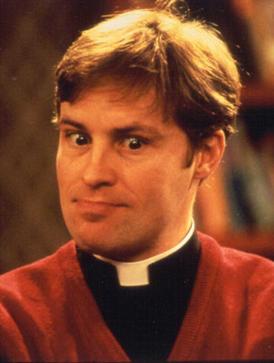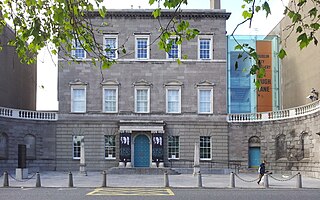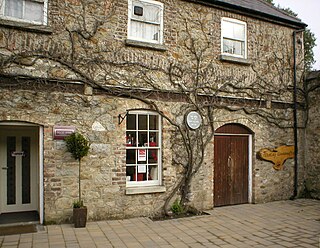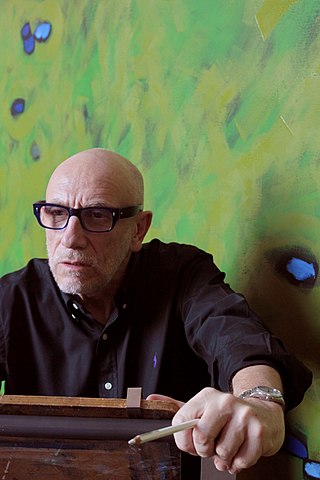Gallery
- Panel 8
- All panels
The "Geneva Window" is a stained glass window consisting of 8 panels, created by Harry Clarke from 1927 to 1930. [1] [2] [3] It was originally commissioned by the Irish Free State government for the League of Nations' International Labour Building in Geneva. [3] However it was rejected, by W.T. Cosgrave and others, for being "offensive", [3] "too provocative" and "unrepresentative". [4] [5] [6] It was instead installed in Government Buildings on Merrion Square before being purchased by Clarke's widow, Margaret, in 1933 for its original cost of IR£450. [7] The window was exhibited at the Hugh Lane Gallery in Dublin and by the Fine Art Society in London before being acquired by Mitchell Wolfson Jr. in 1988. [5] [8] [3]
Clarke was commissioned to produced the window to represent the Free State among other pieces of art from each League of Nations member state. He was free to choose the subject matter, choosing representations of literary characters from 15 Irish texts. [3] [9] [10] The production of the window was hampered by Clarke's struggle with tuberculosis. [3]
The first panel represents Patrick Pearse's The Wayfarer and Lady Gregory's "The Story Brought by Brigit" feature's Saint Brigid. [11]
Joan of Arc as depicted in George Bernard Shaw's play St. Joan is featured in the second panel. [11]
The characters of Christy Mahon and Pegeen Mike, from J.M. Synge's The Playboy of the Western World and fairies from Seumas O'Sullivan's poem The Others are featured in the third panel. [11]
Based on a work of the same name by Liam O'Flaherty. The original panel was removed due to damage, but sold separately. The Hugh Lane Gallery gallery acquired the piece from the Fine Art Society, London, for UK£35,000 in 2015. [12]
The work was the subject of a documentary, "The Geneva Window: Through a Glass Darkly" by Irish actor and comedian Ardal O'Hanlon. [11]

Ardal O'Hanlon is an Irish comedian, actor, and author. He played Father Dougal McGuire in Father Ted (1995–1998), George Sunday/Thermoman in My Hero (2000–2006), and DI Jack Mooney in Death in Paradise (2017–2020). His novel The Talk of the Town was published in 1998.

Henry Patrick Clarke was an Irish stained-glass artist and book illustrator. Born in Dublin, he was a leading figure in the Irish Arts and Crafts Movement.

Bewley's is an Irish hot beverage company, located in Dublin and founded in 1840, which operates internationally. Its primary business operations are the production of tea and coffee, and the operations of cafés. Bewley's has operations in Ireland, the UK and the United States; in the Boston area under the Rebecca's Cafe name and in California as Java City.

Sarah Henrietta Purser RHA was an Irish artist mainly noted for her portraiture. She was the first woman to become a full member of the Royal Hibernian Academy. She also founded and financially supported An Túr Gloine, a stained glass studio.

Carrickmacross is a town in County Monaghan, Ireland. The population was 5,745 at the 2022 census, making it the second-largest town in the county. Carrickmacross is a market town which developed around a castle built by the Earl of Essex in 1630. The town is 20 km west of Dundalk and 75 km north-north-west of Dublin city centre and 106 km south west of Belfast. Carrickmacross won the European Entente Florale Silver Medal Award in 1998.

The Hugh Lane Gallery, and originally the Municipal Gallery of Modern Art, is an art museum operated by Dublin City Council and its wholly-owned company, the Hugh Lane Gallery Trust. It is in Charlemont House on Parnell Square, Dublin, Ireland. Admission is free.

Eva Sydney Hone RHA, usually known as Evie, was an Irish painter and stained glass artist. She is considered to be an early pioneer of cubism, although her best known works are stained glass. Her most notable pieces are the East Window in the Chapel at Eton College, which depicts the Crucifixion, and My Four Green Fields, which is now in the Government Buildings in Dublin.

The Honan Chapel is a small Catholic church built in the Hiberno-Romanesque revival style on the grounds of University College Cork, Ireland. Designed in 1914, the building was completed in 1916 and furnished by 1917. Its architecture and fittings are representative of the Celtic Revival movement and evoke the Insular art style prevalent in Ireland and Britain between the 7th and 12th centuries.

Sir Brian Clarke is a British painter, architectural artist, designer and printmaker, known for his large-scale stained glass and mosaic projects, symbolist paintings, set designs, and collaborations with major figures in modern and contemporary architecture.

Harry Clarke – Darkness in Light is a documentary film originally released in 2003.
Margaret Clarke RHA was an Irish portrait painter.
Catherine Amelia "Kitty" O'Brien was an Irish stained glass artist, and a member and director of An Túr Gloine.
Alfred Ernest Child (1875–1939) was an English stained glass artist, a lecturer in the Dublin Metropolitan School of Art and was associated with An Túr Gloine.

Michael Healy was an Irish stained glass artist, one of a small number which included Wilhelmina Geddes, Evie Hone, and Harry Clarke, who achieved international recognition for their work in this medium in the first half of the 20th century. He also achieved some distinction as an illustrator and cartoonist early on in his artistic career, and as an ongoing recorder of Dublin street characters going about their daily business. Healy also occasionally painted in oil, both portraits and landscapes, exhibiting a small number of the latter during his lifetime.

Nicola (Nikki) Gordon Bowe was an art historian, author and educator. She was a leading author on the Arts and Crafts movement in Ireland, most notably the revival of stained glass as an art form. She was also known for her extensive research and publications on stained glass artists Harry Clarke and Wilhelmina Geddes.
Kathleen Quigly was an Irish stained glass artist, illustrator and painter. She was also a metal worker and jewellery designer.

The Chapel of the Sacred Heart is a neo-gothic chapel in Dingle, County Kerry, Ireland. Attached to Saint Mary's Catholic Church, on Green Street in the center of the town, it was built for a local enclosed order of Presentation Sisters, by the architect C. J. McCarthy in 1886. The original building consisted of a short and narrow nave, flanked by choir stalls, leading to an altar and three stained glass bay windows.

Harry Clarke (1889–1931) was an Irish stained-glass artist and book illustrator. He produced more than 130 stained glass windows, he and his brother Walter having taken over his father's studio after his death in 1921. His glass is distinguished by the finesse of its drawing and his use of rich colours, and an innovative integration of the window leading as part of the overall design, originally inspired by an early visit to see the stained glass of the Cathedral of Chartres. He was especially fond of deep blues. Clarke's use of heavy lines in his black-and-white book illustrations echoes his glass techniques.
Maurice MacGonigal was an Irish landscape and portrait painter and influential teacher.

RGRE Grafton Ltd v Bewley's Cafe Grafton Street Ltd and Bewley’s Ltd is an Irish legal case in the High Court between building owners RGRE Grafton Ltd and tenants Bewley's Cafe Grafton Street Ltd and Bewley's Ltd. The case related to non-payment of rent during the COVID-19 pandemic. RGRE sought a declaration that the stained-glass windows, designed by Harry Clarke, at Bewley's Oriental Café on Grafton Street in Dublin form part of the building and therefore belong to the landlord, as opposed to decorative panels that belong to the tenants.